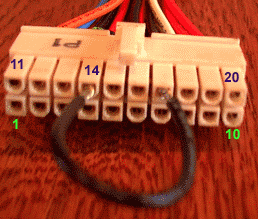|
Connecting 2 ATX PSU's together Power Crazy Why would I want two power supplies (PSUs) in one computer, is this guy crazy? I hear you ask. Well I wouldn't dispute that :-) but many of you will need either an expensive powerful PSU or two cheap 230/250W power supplies if you continue to upgrade your comp. The Athlons now take up quite a bit of your power. Add a few PCI cards and a couple or five CDR / CDROMS and you're about to blow your poor old PSU. Now add a couple of USB items and you're really pushing the poor thing. With the advent of RAID arrays you are looking at 80W+ just to start your HDs up. Whoops, you have blown it for sure. Oh no my comp won't work, what should I do? Well, you can either go out and buy yourself a brand new, very expensive, powerful PSU or you can rummage around and find a couple of cheap lower powered PSU's at around £10 to £15 ($15-$22 USD) and link them together. Preventative maintenance is far cheaper than the cure so if you upgrade before you blow your PSU you will already have one PSU The aims of this Project: In this project not only do I intend to show you how to connect two PSU's together without cutting the cables of the PSUs but I also intend to show you some of the tricks of the trade, i.e. soldering, the use of silicone sealant, striping cables, the best way to join two, or even three, cables and, above all, safety when dealing with electric. Please remember that we are dealing with a maximum of 12V DC and none of the tips and tricks in this article should be applied to mains voltages. Even though the output of a PSU is only a maximum of 12V DC if you allow any form of short or arcing, especially with the high current a PSU is capable of, it could quite easily cause a fire. This can be prevented by the correct use of insulation. This method of connecting 2 PSUs together may not work with all PSUs. Before purchasing any of the apparatus mentioned below please disconnect your PSU from your motherboard and drives etc. Using a piece of wire, connect pin 14 to one of the 6 grounds, i.e. pins 15, 16 and 17 to name but 3. If your PSU kicks in then you are probably safe to continue. If your PSU doesn't kick in then you may like to try shorting pins 7 & 8 as well.
Equipment required: 2 x ATX PSUs, a case capable of taking 2 x ATX PSUs, 2 x ATX extension cables, which were supplied by Quiet PC, 1 tube/can of silicone, which was supplied by B&Q PLC , a length of 3.2mm (1/12")bore heat shrink sheathing, 3 cable ties, a soldering iron and fine flux cored solder, a cigarette lighter, a steady hand and a brain, hmm I'm not sure where these two items are available from :-) Test equipment If possible a cheap/disused motherboard, CPU and stick of memory, which were supplied by Target Computers, and a Volt/Multimeter that is capable of measuring 12V DC. You want to connect as little as possible until you have checked you haven't done anything wrong.
|
